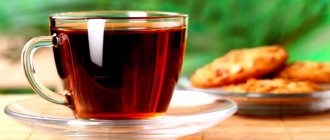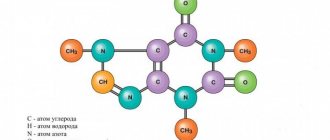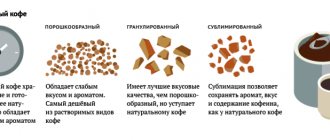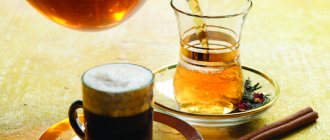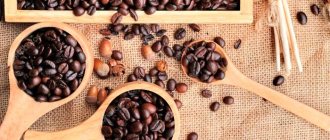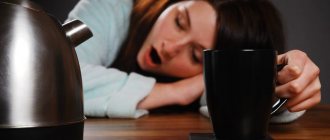Effect of caffeine on the human body
Probably everyone knows that caffeine speeds up the heartbeat and dilates blood vessels. But not many people know that there is a complex effect on metabolism. When you drink a drink that contains caffeine, the amount of adrenaline in your body increases, and this directly affects your mental state and metabolism.
Scientists say that fifty milligrams of caffeine will improve mood and increase productivity, but two hundred or three hundred milligrams will lead to heartbeat disturbances and mild tachycardia.
Consuming four hundred to five hundred milligrams can provoke depression. If you decide to drink a liter of caffeine, death will occur.
But how do you know how much caffeine is in your cup?
Properties of theine
The French chemist Oudry isolated colorless, bitter crystals from tea in 1827. At first they were considered a separate substance, but after five years it was found that both alkaloids are identical in structure and properties. It was later discovered that caffeine analogues are found in cocoa beans, guarana, mate and cola.
The invigorating effect of drinks based on them is explained by the fact that the alkaloid interferes with the normal functioning of the receptors that produce adenosine. This hormone accumulates in the body during active human activity and signals the brain about the need for rest and sleep. With its deficiency, the period of wakefulness lasts longer, and fatigue is felt less.
Caffeine in tea is present in combination with tannin. When brewing, the substance is not completely extracted, so the drink has a much gentler effect on the body. Tannin prevents the rapid absorption of the alkaloid into the blood and promotes its rapid elimination. Unlike caffeine, theine does not accumulate in the body.
Tea stimulates brain function, gives vigor, and causes a surge of strength. Theine improves digestion, dilates blood vessels, and promotes better oxygen supply to cells. The positive effect on the body is maintained only with moderate consumption of the drink. This is especially true for tea with a high alkaloid content.
Table of caffeine content in coffee drinks
It is important to understand that the amount of caffeine ultimately depends on the starting raw material, brewing method and time. The quantity is also affected by the portion. For example, espresso has a serving of thirty milligrams, which means forty to seventy-five milligrams of caffeine.
It is a misconception that tea does not contain as much caffeine as coffee. For example, a small cup of instant coffee will have less caffeine than a large cup of strongly brewed tea. By the way, caffeine is also found in carbonated drinks.
Caffeine Content Table
| Drink, ml | Amount of caffeine (approximately, mg) |
| Natural coffee, 250 | 100-200 |
| Instant coffee, 100 | 30-50 |
| Decaffeinated coffee, 250 | 2-30 |
| Espresso, 30 | 40-75 |
| Black tea, 100 | 40-50 |
| Green tea, 100 | 20-30 |
| Energy, 250 | 70-100 |
| Drink with gases, 330 | 20-40 |
| Iced tea in bottles, 330 | 5-40 |
| Hot chocolate drink, 240 | 5-10 |
| Chocolate ice cream | 30-45 |
| Dark chocolate, 100 g | 30-50 |
How much caffeine is in tea
The percentage of theine in the same type of tea may differ. The amount of substance in tea leaves depends on several factors:
- growing conditions;
- agricultural technology;
- post-processing.
The fermentation method has a significant influence on the theine content. During drying, the leaf curls and releases juice, in which the process of natural fermentation takes place. The tea is then roasted or steamed. By adjusting temperature, humidity and air access, a product with different properties is obtained. During fermentation, the chemicals break down, so the less the leaf is processed, the more theine it retains.
Specialists from the Medical College of Taiwan University conducted a study of more than three dozen varieties of tea. The general chemical composition of the drink was studied using samples obtained by brewing one gram of leaf per 100 ml of water. As a result, it turned out that large-leaf green tea contains the highest percentage of caffeine, and oolong teas with a bush age of more than four years showed the lowest content.
The caffeine content of different types of tea per gram of dry product, according to the results of a study by scientists at Taiwan University:
- large leaf green tea – 26–32 mg;
- green tea from buds – 22–30 mg;
- pu-erh – 18–30 mg;
- red tea – 19–25 mg;
- white varieties – 18–20 mg;
- oolongs – 12–29 mg.
Mainly Chinese and Taiwanese types of tea were studied. It was noted that indicators may vary depending on the variety, and the results indicate only a general trend.
Lipton holds the record for caffeine content. Scientists analyzed crushed tea in ordinary bags and found 32 mg of alkaloid per 1 g of dry leaves.
What harm does coffee cause?
Two hundred to three hundred milligrams per day is considered a safe amount of coffee for humans. According to the caffeine content table, this is approximately three cups of espresso.
As you know, caffeine addiction exists. But it appears if you consume more than three hundred to five hundred milligrams per day. A one-time intake of half a liter of caffeine has a bad effect on the human psyche.
Scientists say that large amounts of caffeine provoke paranoia and anxiety attacks. Many people know that if you drink too much coffee, insomnia becomes your best friend.
What is caffeine and what does it do?
Caffeine is a naturally occurring chemical found in the leaves and fruits of more than 60 plants, including the leaves of tea plants (5).
It is a central nervous system stimulant that is consumed worldwide to increase energy levels and combat fatigue and drowsiness. It blocks the effects of a neurotransmitter called adenosine, which builds up throughout the day and makes you feel tired (6).
Caffeine consumption is also associated with a number of health benefits, such as improved mood and brain function, increased metabolism, and improved physical performance (7, 8, 9).
However, some people may be more sensitive to the effects of caffeine than others (10, 11).
Additionally, people who consume too much caffeine may experience anxiety, insomnia, or irregular heartbeat (12).
Summary:
Caffeine is a natural stimulant that can help you stay alert. Its consumption may also have some beneficial effects on the body, such as improved brain function.
Advantages and Disadvantages of Quitting Caffeine
Caffeine is only effective if you consume it only occasionally. But if you are a daily coffee drinker, you will start to feel uncomfortable when you give it up.
Headache, decreased activity, insomnia are the consequences of abrupt caffeine withdrawal. Usually such symptoms disappear after three to four days.
Conclusion
The amount of caffeine depends on the quality of the product and the brewing method. As you can see from the caffeine content table, instant coffee generally does not contain much more caffeine than black tea. When taking energy drinks, the effect of caffeine becomes more pronounced.
Why then do tea and coffee act differently?
Let’s say there is only one molecule, but then a reasonable question arises about the difference in the effect produced. Coffee is considered a stimulant, while tea is considered a stimulant. If both contain the same substance, why does it manifest itself so differently?
The answer to this question is based on three factors - the number of molecules, the rate of absorption and the individual tolerance of our body.
1. The concentration of caffeine molecules in coffee is three to four times higher than in tea.
Although initially there is more caffeine in the tea leaf than in the coffee bean, the degree of caffeine from the two ready-made drinks is higher (caffeine is extracted from ground beans better than from leaves). By the way, the concentration also depends on the type of tea, but not so significantly: the final amount of caffeine in your cup consists of the infusion time, the fraction of the leaf and its ability to release caffeine molecules. So, for example, in tea that has been steeped for 5 minutes, there will always be more of this substance than in tea that has been brewed for 1 or 2 minutes. Black tea releases caffeine faster than white tea, and whole leaves release it more slowly than crushed leaves.
2. Although theine and caffeine molecules are absolutely identical, they can be associated with other substances in the drink, and their breakdown in our body occurs at different rates.
The molecules of coffee beans are much looser than those of tea and are not bound to other substances. They are well absorbed by the body and therefore enter our circulatory system much faster. This is why we feel the effects of coffee so vividly.
Coffee beans LavAzza “Qualita Oro”, 500 g 752 rub.
Lavazza “Qualita Oro” coffee beans, 250 g 351 rub.
Ground coffee in instant Nescafe “Gold”, 750 g -25%
745 rub. 993 rub.
Compagnia Dell'arabica "Jamaica Blue Mountain" bean coffee, 1500 g 48,960 rub.
Ground coffee Lebo “Extra”, for Turkish, 75 g 61 rub.
Coffee capsules Coffesso “Coffee set”, assorted for Nespresso coffee machine, 50 capsules -25%
961 rub. 1281 rub.
Coffee beans Paretto “Celesto”, freshly roasted, 1000 g 1619 rub.
Instant coffee Ambassador “Platinum”, 95 g 230 rub.
Choose coffee on TEA.ru
In the case of theine, the opposite is true. Theine molecules are typically bound to other substances found only in tea, and the body needs to break these bonds before the theine can be absorbed. This is why tea affects us longer and more gently.
3. We are all different, so our reaction to either of these two drinks may vary unpredictably.
Some people are more sensitive to coffee, while others are more sensitive to tea. The only way to know which of these drinks affects you more is to simply try them and compare.
Why do we drink these drinks
Pleasant taste, beneficial properties and a boost of energy (see why it is not recommended to drink a lot of coffee). You and I get all this from a cup of coffee and tea .
The caffeine contained in these drinks has a strong effect on our body. Let's start with the positives.
- Stimulates the nervous system (see products containing caffeine). The result is a temporary increase in activity.
- Scientists have proven the effect on the area in the brain responsible for breathing. After drinking a mug of black drink, more active lung function is observed. Taking this information into account, we can conclude that caffeine has a good effect on respiratory functions (see can you drink coffee before donating blood).
- Increases the rate of burning excess fat and calories (see how many calories are in coffee).
- The feeling of hunger decreases. We conclude that caffeine helps you lose weight.
But despite the obvious advantages, there are also harmful effects.
- I tell you by my example. Coffee is highly addictive (see why you always want coffee). As a result of this, you will increase the dose of caffeine, and your body will begin to work worse. There will be drowsiness, a drop in general tone, irritability and muscle pain (see can you drink coffee with gastritis).
- Evidence of the development of mental illnesses was noted: psychosis, epilepsy and paranoia. Thus, a temporary improvement in the functioning of the central nervous system will ultimately lead to its destruction.
- Excessive consumption leads to deterioration in the absorption of important microelements - calcium, potassium, magnesium, etc.
Below you will find an infographic that provides a brief summary.
Decaffeinated green tea: fiction or fact?
Recently, more and more people are beginning to carefully monitor their health, radically changing their usual diet. Even such traditional products as tea have undergone changes. In addition to regular varieties, special ones marked “caffeine-free” have also appeared in stores. Is there really a special technology to remove caffeine from the leaves or is it just a clever marketing ploy?
In fact, everything is very simple, black or green tea that does not contain caffeine does exist. For its production, the lowest and oldest leaves of the tea bush are used. The maximum caffeine content is found in the upper leaves and buds of the plant, but only expensive and elite varieties of the drink are obtained from these raw materials. In the lower part of the plant, the amount of caffeine is much lower, but the manufacturer positions the “new product” as exclusively special varieties. In fact, it turns out that decaffeinated tea is represented by low-quality raw materials, and the cost can reach the price of elite varieties. In addition, such a drink still contains caffeine, albeit in lower concentrations.
You may be interested in: Is it possible to drink tea with gastritis: necessary restrictions
It's a different matter when it comes to fruit or flower drinks. Even the content of aromatic additives reduces the concentration of the substance, and if the brew consists entirely of flowers and dried fruits, there will be no caffeine in such drinks. Other types of decaf tea include rooibos and hibiscus, which do not contain tea leaves. You can also reduce the caffeine content by adding lemon, honey or cream to your regular drink.
